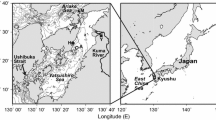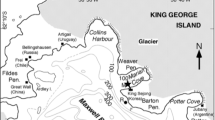Abstract
Eucampia zodiacus Ehrenberg is harmful, as it causes reduction in the quality of the aquacultured Porphyra thalli owing to nutrient depletions during dense blooms in the late winter in the macrotidal Ariake Sea, Japan. To understand the mechanism of bloom development, changes in the abundance of E. zodiacus during a bloom were investigated along vessel transects from February to April 2012. In addition, marine environmental variables were continuously monitored by the Ariake Sea Monitoring Tower, which revealed that turbidity periodically decreased during neap tides. During the 16 February neap tide, a high Secchi depth (4.3 m) was recorded at offshore stations and the Z 1% depth, at which the light intensity attenuates to 1 % of that at the sea surface, exceeded the water depth. On 16 February, the abundance of E. zodiacus was 52–732 cells mL−1, peaking at 7.0 m depth offshore. Subsequently, abundance increased at all stations. During the 22 February spring tide, abundance became vertically uniform. On 19 March, abundance at the tower reached 3758 cells mL−1 at the surface. We conclude that an improvement in light conditions in the deeper layer triggered the bloom, although the size and the duration of the bloom were determined by nutrient availability. Thus, decreases in turbidity during neap tides and subsequent strong vertical mixing during spring tides may be instrumental in the population dynamics of the large diatom E. zodiacus in macrotidal environments.











Similar content being viewed by others
References
Allen GP, Salomon JC, Bassoullet P, Du Penhoat Y, De Grandpre C (1980) Effects of tides on mixing and suspended sediment transport in macrotidal estuaries. Sediment Geol 26:69–90
Bienfang PK, Harrison PJ (1984) CO-variation of sinking rate and cell quota among nutrient replete marine phytoplankton. Mar Ecol Prog Ser 14:297–300
Bienfang PK, Harrison PJ, Quarmby LM (1982) Sinking rate response to depletion of nitrate, phosphate and silicate in four marine diatoms. Mar Biol 67:295–302
Cloern JE, Alpine AE, Cole BE, Wong RLJ, Arthur JF, Ball MD (1983) River discharge controls phytoplankton dynamics in the northern San Francisco Bay estuary. Estuar Coast Shelf Sci 16:415–429
Del Amo Y, Le Pape O, Treguer P, Queguiner B, Menesguen A, Aminot A (1997) Impacts of high-nitrate freshwater inputs on macrotidal ecosystems I. Seasonal evolution of nutrient limitation for the diatom-dominated phytoplankton of the Bay of Brest (France). Mar Ecol Prog Ser 161:213–224
Durbin EG (1978) Aspects of the biology of resting spores of Thalassiosira nordenskioeldii and Detonula confervacea. Mar Biol 45:31–37
Garrison DL (1981) Monterey Bay phytoplankton II. Resting spore cycles in coastal diatom populations. J Plankton Res 3:137–156
Gosling E (2003) Bivalve molluscs: biology, ecology, and culture. Blackwell Science, Malden, p 456
Graneli E, Turner JT (2006) Ecology of harmful algae. Springer, Berlin, p 415
Guezennec L, Laftte R, Dupont J-P, Meyer R, Boust D (1999) Hydrodynamics of suspended particulate matter in the tidal freshwater zone of a macrotidal estuary (the Seine estuary, France). Estuaries 22:717–727
Hori Y, Nakatani A, Nishikawa T, Suzuki T, Takabe T (2006) Population dynamics of the harmful diatom Eucampia zodiacus and changes on the environmental factors of winter season in Harima-Nada, eastern Seto Inland Sea, Japan. J Adv Mar Sci Technol Soc 12:13–22 (in Japanese with English Abstract)
Horner RA (2002) A taxonomic guide to some common marine phytoplankton. Biopress, London, p 195
Itakura S, Imai I, Itoh K (1992) Morphology and rejuvenation of Skeletonema costatum (Bacillariophyceae) resting cells from the bottom sediments of Hiroshima bay, the Seto inland sea, Japan. Bull Plankton Soc Jpn 38:135–145 (in Japanese with English Abstract)
Ito Y, Hayami Y, Katano T, Koriyama M (2012) Seasonal and spring-neap tidal changes in ocean structure of the lower Chikugo River estuary based on monitoring data from oceanographic observation tower. Oceanogr Jpn 21:1–16 (in Japanese with English Abstract)
Japan Fisheries Resource Conservation Association (2012) Kyushu-kai-iki no akashio. http://ay.fish-jfrca.jp/ariake/db/index.asp. Accessed 13 Sept 2012
Katano T, Yoshino K, Matsubara T, Hayami Y (2012) Wax and wane of Chattonella (Raphidophyceae) bloom with special reference to competition between Skeletonema (Bacillariophyceae) in the Ariake Sea, Japan. J Oceanogr 68:497–507
Koh C-H, Khim JS, Araki H, Yamanishi H, Mogi H, Koga K (2006) Tidal resuspension of microphytobenthic chlorophyll a in a Nanaura mudflat, Saga, Ariake Sea, Japan: flood–ebb and spring–neap variations. Mar Ecol Prog Ser 312:85–100
Lee JHW, Hodgkiss IJ, Wong KTM, Lam IHY (2005) Real time observations of coastal algal blooms by an early warning system. Estuar Coast Shelf Sci 65:172–190
Martin JL, Hastey CD, LeGresley MM, Page FH (2007) Temporal and spatial characteristics of the diatom Eucampia zodiacus in the Western Isles of the Bay of Fundy. Can Tech Rep Fish Aquat Sci 2705:1–22
Matsubara T (2012) Current status and issues of the Ariake Bay, a potentially highly productive coastal sea. In: Oshima Y (ed) Kouseisha-kouseikaku, pp 9–24 (in Japanese)
Nakamura Y, Shinotsuka Y (2007) Suspension feeding and growth of ark shell Anadara granosa: comparison with ubiquitous species Scapharca subcrenata. Fish Sci 73:889–896
Nishikawa T (2002) Effects of temperature, salinity and irradiance on the growth of the diatom Eucampia zodiacus caused bleaching of seaweed Porphyra isolated from Harima-Nada, Seto Inland Sea, Japan. Nippon Suisan Gakkaishi 68:356–361 (in Japanese with English abstract)
Nishikawa T, Hori Y (2004) Effects of nitrogen, phosphorus and silicon on the growth of the diatom Eucampia zodiacus caused bleaching of seaweed Porphyra isolated from Harima-Nada, Seto Inland Sea, Japan. Nippon Suisan Gakkaishi 70:31–38 (in Japanese with English abstract)
Nishikawa T, Yamaguchi M (2006) Effect of temperature on light-limited growth of the harmful diatom Eucampia zodiacus Ehrenberg, a causative organism in the discoloration of Porphyra thalli. Harmful Algae 5:141–147
Nishikawa T, Hori Y, Tanida K, Imai I (2007) Population dynamics of the harmful diatom Eucampia zodiacus Ehrenberg causing bleachings of Porphyra thalli in aquaculture in Harima-Nada, the Seto Inland Sea, Japan. Harmful Algae 6:763–773
Nishikawa T, Tarutani K, Yamamoto T (2009) Nitrate and phosphate uptake kinetics of the harmful diatom Eucampia zodiacus Ehrenberg, a causative organism in the bleaching of aquacultured Porphyra thalli. Harmful Algae 8:513–517
Nishikawa T, Hori Y, Nagai S, Miyahara K, Nakamura Y, Harada K, Tada K, Imai I (2011) Long time-series observations in population dynamics of the harmful diatom Eucampia zodiacus and environmental factors in Harima-Nada, eastern Seto Inland Sea, Japan during 1974–2008. Plankton Benthos Res 6:26–34
O’Brien DJ, Whitehouse RJS, Cramp A (2000) The cyclic development of a macrotidal mudflat on varying timescales. Cont Shelf Res 20:1593–1619
Oku O, Kamatani A (1999) Resting spore formation and biochemical composition of the marine planktonic diatom Chaetoceros pseudocurvisetus in culture: ecological significance of decreased nucleotide content and activation of the xanthophyll cycle by resting spore formation. Mar Biol 135:425–436
Pennock JR (1985) Chlorophyll distributions in the Delaware estuary: regulation by light-limitation. Estuar Coast Shelf Sci 21:711–725
Poole HH, Atkins WRG (1929) Photo-electric measurements of submarine illumination throughout the year. J Mar Biol Assoc UK 16:297–324
Saga Prefectural Government (2012) Nori-Yoshoku information (no. 28 and 29). http://www.pref.saga.lg.jp/web/saga_ariakesenta.html. Accessed 5 Apr 2013
Sakshaug E, Andresen K (1986) Effect of light regime upon growth rate and chemical composition of a clone of Skeletonema costatum from the Trondheimsfjord, Norway. J Plankton Res 8:619–637
Sasaki K, Kito H (2003) Growth characteristics of Rhizosolenia imbricate Brightwell occurring in Ariake Sea. Bull Plankton Soc Jpn 50:79–87 (in Japanese with English abstract)
Sugie K, Kuma K (2008) Resting spore formation in the marine diatom Thalassiosira nordenskioeldii under iron- and nitrogen-limited conditions. J Plankton Res 30:1245–1255
Tanaka K, Kodama M, Kumagai K, Fujimoto H (2004) Variations in in situ fluorescence of phytoplankton pigments and turbidity during winter in the Chikugo River estuary. Oceanogr Jpn 13:163–172 (in Japanese with English abstract)
Tattersall GR, Elliott AJ, Lynn NM (2003) Suspended sediment concentrations in the Tamar estuary. Estuar Coast Shelf Sci 57:679–688
Van Beusekom JEE, Loebl M, Martens P (2009) Distant riverine nutrient supply and local temperature drive the long-term phytoplankton development in a temperate coastal basin. J Sea Res 61:26–33
Welschmeyer NA (1994) Fluorometric analysis of chlorophyll a in the presence of chlorophyll b and pheopigments. Limnol Oceanogr 39:1985–1992
Yoshida K, Chiba S, Ishimaru T (2011) Long-term variation in the wintertime diatom community structure in Tokyo Bay, Japan (1981–2000). Plankton Benthos Res 6:195–205
Author information
Authors and Affiliations
Corresponding author
Rights and permissions
About this article
Cite this article
Ito, Y., Katano, T., Fujii, N. et al. Decreases in turbidity during neap tides initiate late winter blooms of Eucampia zodiacus in a macrotidal embayment. J Oceanogr 69, 467–479 (2013). https://doi.org/10.1007/s10872-013-0187-3
Received:
Revised:
Accepted:
Published:
Issue Date:
DOI: https://doi.org/10.1007/s10872-013-0187-3




